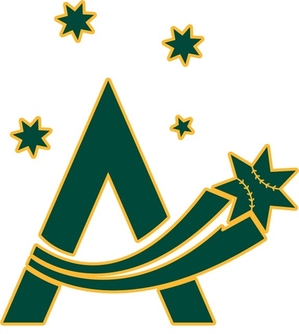Australia women's national baseball team
 |
|
| Country |
|
|---|---|
| Federation | Australian Baseball Federation |
| Confederation | Baseball Confederation of Oceania |
| Manager |
|
| Uniforms | |
 |
|
| Women's World Cup | |
| Appearances | 6 (First in 2004) |
| Best result |
|
|
Women's Baseball World Cup |
|
|---|---|
| Tournament Results | |
|
|
4th |
|
|
4th |
|
|
4th |
|
|
2nd |
|
|
4th |
|
|
3rd |
| Medal Tally | |
| Gold | – |
| Silver | 1 |
| Bronze | 1 |
The Australian women's national baseball team, nicknamed the Emeralds, represents Australia in international women's baseball tournaments and competitions. The team is controlled by the Australian Baseball Federation, which is represented in the Baseball Confederation of Oceania (BCO). They are the only team in Oceania to be formally ranked by the International Baseball Federation (IBAF), and are the 3rd ranked women's baseball team in the world. The Emeralds have been in existence since 2001, when the first ever squad was selected from the 2001 National Women’s Championships, held in Sydney. They compete in the biennial IBAF Women’s Baseball World Cup.
The team has competed at all six Women's Baseball World Cups, most recently finishing third in 2014. The next major tournament will be the 2016 Women's Baseball World Cup, which will be held in Gijang City, South Korea in September.
Pitchers
Outfield
Infield
Catcher
Head Coach - Simone Wearne
Assistant Coach - Dean White
Assistant Coach - Narelle Gosstray
Assistant Coach - Luke Hughes
Pitching Coach - Graeme Lloyd
Physio - Jonni Ralph
Executive Officer - David Nagy
Technical Analyst - Yasunori Sato
In August 2009 the International Baseball Federation created a ranking system so that the nations involved in international competition could be compared independently. Teams receive points based on the position they finish at the end of World Cup tournaments. Only results at the previous three tournaments years are used, so points are added and removed over time. Points are also weighted so that more recent tournaments have a greater impact on the rankings. Since the rankings were introduced, two editions have been released, the most recent released after the 2010 World Cup.
...
Wikipedia
